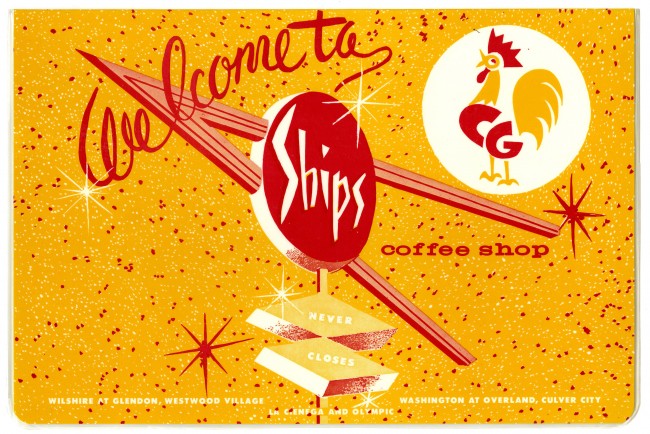Pictured above: Ships Coffee Shop, 1971. (Image courtesy of Los Angeles Public Library)
by KARIN CHAN
editor@charactermedia.com
Can the history of a city be told through its restaurant menus? Visitors to the Los Angeles Public Library may ask themselves this question as they feast their eyes on a rare collection of old menus, now on display at the Central Library through November 13.
The exhibit, “To Live and Dine in L.A.,” shares the same name with a book published in partnership with Angel City Press, which includes a foreword by L.A.-based chef and restaurateur Roy Choi.
Written by Josh Kun, an author and associate professor of communication at the Annenberg School at the University of Southern California, To Live and Dine in L.A. explores the history, urban growth and social stratification of Los Angeles through food menus spanning as far back as 1875 to the 1980s.
 Kelbo’s (1950s)
Kelbo’s (1950s)
The collection of menus is the result of a decades-long effort that began when two LAPL librarians began collecting menus in the 1980s; today, the library has amassed around 15,000 menus. Choi was one of those who helped curate the collection of roughly 200 menus for the book and exhibit.
“The menus we saw told us a story, but what were the ones missing telling us?” he told KoreAm by email—adding of the collection, “Expect to think about the haves and have-nots and expect to sit and experience the growth of a city with all its bumps and bruises and how that’s a reflection of today as well.”

Included in the collection are menus from the likes of such ritzy restaurants as Wolfgang Puck’s Spago, which was branded as “Californian Cuisine” in 1981, with its offerings of crab ravioli and Chinese-style duck breast. Conspicuously absent, however, are menus catering to California’s working class: After all, food trucks that stopped outside construction sites or lunchrooms had no handheld menus, opting to write food items on boards or not having them written at all.
Choi told KoreAm that the disparity between the rich and poor reflected in these sampling of menus reveals other aspects of the city’s history. “I found the racial propaganda surprising,” he said.
Indeed, one featured menu is from the Golden Pagoda restaurant, whose cover artwork appeals to “Western stereotypes of Asian culture,” Kun writes in the book. The 1943 menu depicts an image of a pagoda structure and rickshaw driver and uses a font associated with traditional Asian-style calligraphy brushstrokes.
 Golden Pagoda (1943)
Golden Pagoda (1943)
In Choi’s foreword for To Live and Dine in L.A., he writes that most places he grew up eating in didn’t have menus—such as his home, burger stands and delis. (Fans of the chef may recall he wrote about his youth and L.A.’s food culture in his 2013 memoir, L.A. Son: My Life, My City, My Food.)
While most people may know Choi as the founder of gourmet Korean taco truck, Kogi, the Angeleno is not only a seasoned chef but also an activist, as he applies his culinary background to help address the still-existent social disparity of food accessibility in L.A.
Since opening in 2013, Choi’s South Central L.A. restaurant, 3 Worlds Café, has partnered with nearby Jefferson High School to sell healthy, all-fruit smoothies, coffee and other items. The mission of the project is to create equitable access to healthy food and foster the development of young entrepreneurs. Choi is also preparing to open his fast food restaurant, loco’l, which will aim to serve healthier and affordable food options in Watts.
When asked what inspired the project, Choi replied, “They are my friends and family. I’m here to feed. That’s all. And I give a f—.”

The Redwood House (1945)
Recognizing that it’s a privilege to be able to dictate what is on the menu today, Choi wants those who visit the exhibit or pick up the book to get to know L.A. better, warts and all.
“You can see L.A., right before your eyes, grow through these menus and ask questions about what is and was and what is and isn’t,” he said.
For more information on To Live and Dine in L.A., visit its official website.
___
With additional reporting by the Associated Press. All images courtesy of Los Angeles Public Library.
See Also
[VIDEO] A Conversation with Chefs Corey Lee and Roy Choi





